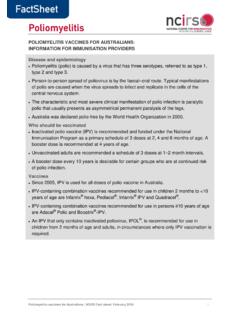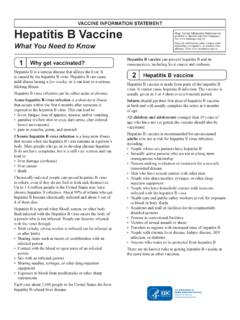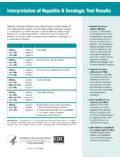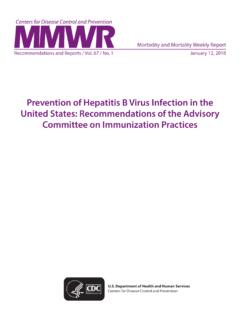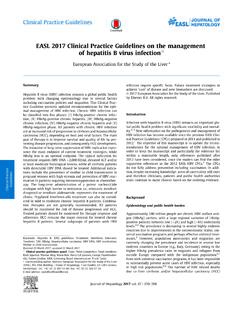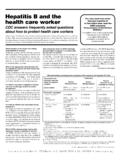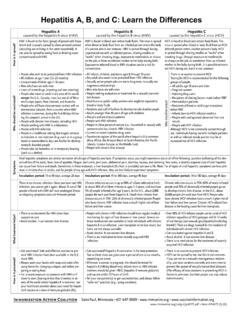Transcription of Hepatitis B vaccines for Australians - fact sheet
1 Hepatitis B. Hepatitis B vaccines FOR Australians : INFORMATION FOR IMMUNISATION PROVIDERS. Disease and epidemiology Hepatitis B is a viral disease that primarily affects the liver. Most infected young children are asymptomatic, but a high proportion become chronically infected, especially if they are infected perinatally. A substantial proportion of chronically infected individuals will develop liver cirrhosis and/or hepatocellular carcinoma, which account for considerable morbidity and mortality. In Australia, groups with a higher prevalence of chronic Hepatitis B infection include persons who inject drugs, Aboriginal and Torres Strait Islander people, migrants from Hepatitis B endemic regions, men who have sex with men, and inmates of correctional facilities.
2 The Hepatitis B virus is transmitted through contact with blood or body fluid of an infectious person, and is commonly acquired either perinatally, by sexual contact, by non-sexual close contact or by exposure to infectious fluids. Vaccination is the best way to prevent Hepatitis B. Who should be vaccinated All infants Children/young adolescents catch-up vaccination for those not previously immunised Adults at higher risk of: (1) exposure to Hepatitis B infection, due to frequent close contact with infected persons, certain personal risk factors, occupational exposure or travel to areas where Hepatitis B is endemic; (2) severe disease, due to certain medical conditions or treatments.
3 Vaccine The Hepatitis B vaccine is a subunit vaccine containing Hepatitis B surface antigen produced by recombinant DNA technology. It is safe and highly effective. Different vaccination schedules are recommended for different age groups/settings: For infants: birth dose, then at 2, 4 and 6 months of age For children/adolescents and adults: standard 3-dose schedule (at 0, 1 and 6 months from 1st dose). For adolescents aged 11 15 years: a 2-dose schedule using adult formulation vaccine is also acceptable. Other schedules can be indicated for adults with particular medical conditions and for travellers. Hepatitis B vaccines for Australians | NCIRS Fact sheet : July 2015 1.
4 The disease acquisition, HBV viral load, histological type of Hepatitis B disease is caused by the Hepatitis B virus chronic Hepatitis , and aggravating factors like alcohol (HBV), a DNA virus. It primarily affects the liver. The consumption and co-infection with other hepatotropic virus replicates in the hepatocytes of the liver and may ,2,8. lead to liver dysfunction as well as immune-mediated Diagnosis liver cell ,2 HBV infection is a major global Specific diagnosis of HBV infection is based on health problem; it is estimated that >240 million people serologic and/or nucleic acid testing. have chronic Hepatitis B3 and >680,000 deaths occur annually due to complications of Hepatitis B Hepatitis B surface antigen (HBsAg) and antibodies to the Hepatitis B core antigen (anti-HBc antibodies) are Clinical features markers of infection.
5 The Hepatitis B early antigen Infection with HBV can be asymptomatic or manifest (HBeAg) is associated with a high level of viral as either acute or chronic disease. replication and, hence, high ,2,8 Nucleic acid The majority of acute HBV infections are not clinically tests are also used in diagnosis and sensitive tests can recognised. Acute Hepatitis B infection is usually detect HBV DNA in the serum of an infected person asymptomatic in young children, but symptomatic 10 20 days before detection of Antibody disease with jaundice occurs in about 30 50% of against Hepatitis B surface antigen (anti-HBs antibody). infected ,5 Clinical symptoms and signs of viral is a marker of immunity, acquired after either natural Hepatitis are not specific to Hepatitis B, and may infection or vaccination.
6 Include systemic symptoms like fever, malaise, Treatment fatigability, anorexia, nausea and vomiting, abdominal Treatment for acute HBV infection is generally pain, and myalgia. In patients who develop jaundice, it supportive. usually appears 1 2 weeks after onset of systemic symptoms and lasts about 1 3 weeks. The incubation Current antiviral therapy of chronic Hepatitis B does period from virus exposure to onset of jaundice ranges not eradicate HBV. The aim of treatment for chronic from about 45 to 180 days, with an average of 90 HBV infection is to reduce the risk of developing ,2,6 During convalescence, fatigue and malaise chronic liver disease by sustained suppression of HBV.
7 Can persist for up to several months. Potentially fatal replication in the Long-term treatment with fulminant Hepatitis occurs in approximately of antiviral drugs has been shown to be effective in acute adult cases, but is rarer in ,2 reducing the risk of both disease progression and of developing HCC. A systematic review found incidence A very high proportion (up to 90%) of children of HCC to be >50% lower among patients on infected with HBV in early infancy will become Patients who are identified as chronically chronically The proportion who become infected with HBV should be referred to a specialist chronically infected decreases with increasing age at Hepatitis clinic for further clinical assessment and infection, to <10% among infected ,7 Chronic consideration of antiviral therapy.
8 HBV infection is identified by persistence of Hepatitis B surface antigen (HBsAg) in the blood for at least 6 Epidemiology months. Clearance of HBsAg among the chronically HBV is a major global health problem and causes infected is unusual, occurring in <1% per approximately 686,000 deaths worldwide each Chronic HBV infection can lead to liver cirrhosis Areas of high endemicity, indicated by HBsAg and/or hepatocellular carcinoma (HCC), which are the seroprevalence of 8% or higher, include most of East major contributors to morbidity and mortality of and South-east Asia (except Japan), Pacific Island chronic HBV ,2 groups, parts of central Asia, the Amazon Basin and sub-Saharan In these regions, infections are Some chronically HBV infected persons may remain mainly acquired perinatally or in early childhood.
9 Asymptomatic. Symptoms of chronic Hepatitis B. disease are usually non-specific, unless there is Hepatitis B in Australia cirrhosis or HCC, and do not correspond to disease Australia is categorised as a low prevalence' country severity. It is estimated that 15 25% of people with for HBV infection ( <2% of the population is chronic Hepatitis B will die from liver cirrhosis or HBsAg-positive). In 2013, HBsAg seroprevalence was ,8 Prognostic factors include age of HBV estimated at approximately However, this still equates to approximately 210,000 people living with Hepatitis B vaccines for Australians | NCIRS Fact sheet : July 2015 2.
10 Chronic Hepatitis B infection with an estimated 389 through other skin-penetrating or mucous deaths due to chronic HBV infection in Australia in membrane exposures to blood or other bodily Population groups with higher prevalence of fluids; common scenarios include: chronic Hepatitis B, compared with the general o sharing of needles and other injecting drug Australian population, include:13,14. equipment persons who inject drugs o inadequately sterilised skin penetrating Aboriginal and Torres Strait Islander people instruments ( tattooing equipment, body- piercing equipment, acupuncture needles). migrants from Hepatitis B endemic regions o needle-stick injury ( in a healthcare setting).
